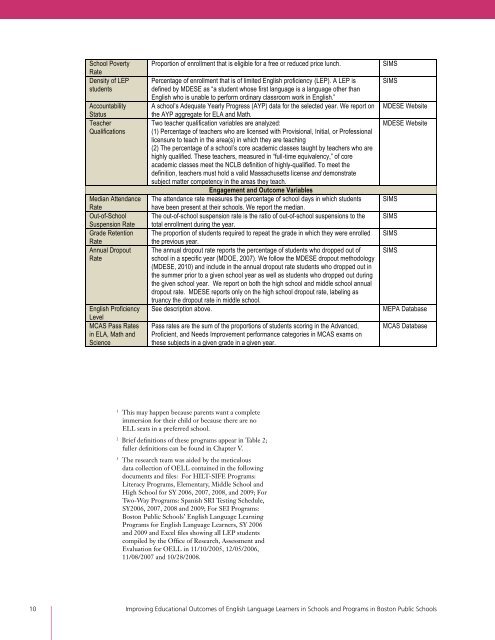Full Report - Center for Collaborative Education
Full Report - Center for Collaborative Education
Full Report - Center for Collaborative Education
You also want an ePaper? Increase the reach of your titles
YUMPU automatically turns print PDFs into web optimized ePapers that Google loves.
School Poverty<br />
Rate<br />
Density of LEP<br />
students<br />
Accountability<br />
Status<br />
Teacher<br />
Qualifications<br />
Median Attendance<br />
Rate<br />
Out-of-School<br />
Suspension Rate<br />
Grade Retention<br />
Rate<br />
Annual Dropout<br />
Rate<br />
English Proficiency<br />
Level<br />
MCAS Pass Rates<br />
in ELA, Math and<br />
Science<br />
!<br />
Proportion of enrollment that is eligible <strong>for</strong> a free or reduced price lunch. SIMS<br />
Percentage of enrollment that is of limited English proficiency (LEP). A LEP is<br />
defined by MDESE as “a student whose first language is a language other than<br />
English who is unable to per<strong>for</strong>m ordinary classroom work in English.”<br />
A school’s Adequate Yearly Progress (AYP) data <strong>for</strong> the selected year. We report on<br />
the AYP aggregate <strong>for</strong> ELA and Math.<br />
Two teacher qualification variables are analyzed:<br />
(1) Percentage of teachers who are licensed with Provisional, Initial, or Professional<br />
licensure to teach in the area(s) in which they are teaching<br />
(2) The percentage of a school’s core academic classes taught by teachers who are<br />
highly qualified. These teachers, measured in “full-time equivalency,” of core<br />
academic classes meet the NCLB definition of highly-qualified. To meet the<br />
definition, teachers must hold a valid Massachusetts license and demonstrate<br />
subject matter competency in the areas they teach.<br />
Engagement and Outcome Variables<br />
The attendance rate measures the percentage of school days in which students<br />
have been present at their schools. We report the median.<br />
The out-of-school suspension rate is the ratio of out-of-school suspensions to the<br />
total enrollment during the year.<br />
The proportion of students required to repeat the grade in which they were enrolled<br />
the previous year.<br />
1 This may happen because parents want a complete<br />
immersion <strong>for</strong> their child or because there are no<br />
ELL seats in a preferred school.<br />
2 Brief definitions of these programs appear in Table 2;<br />
fuller definitions can be found in Chapter V.<br />
3 The research team was aided by the meticulous<br />
data collection of OELL contained in the following<br />
documents and files: For HILT-SIFE Programs:<br />
Literacy Programs, Elementary, Middle School and<br />
High School <strong>for</strong> SY 2006, 2007, 2008, and 2009; For<br />
Two-Way Programs: Spanish SRI Testing Schedule,<br />
SY2006, 2007, 2008 and 2009; For SEI Programs:<br />
Boston Public Schools’ English Language Learning<br />
Programs <strong>for</strong> English Language Learners, SY 2006<br />
and 2009 and Excel files showing all LEP students<br />
compiled by the Office of Research, Assessment and<br />
Evaluation <strong>for</strong> OELL in 11/10/2005, 12/05/2006,<br />
11/08/2007 and 10/28/2008.<br />
10 Improving <strong>Education</strong>al Outcomes of English Language Learners in Schools and Programs in Boston Public Schools<br />
SIMS<br />
MDESE Website<br />
MDESE Website<br />
SIMS<br />
SIMS<br />
SIMS<br />
The annual dropout rate reports the percentage of students who dropped out of SIMS<br />
school in a specific year (MDOE, 2007). We follow the MDESE dropout methodology<br />
(MDESE, 2010) and include in the annual dropout rate students who dropped out in<br />
the summer prior to a given school year as well as students who dropped out during<br />
the given school year. We report on both the high school and middle school annual<br />
dropout rate. MDESE reports only on the high school dropout rate, labeling as<br />
truancy the dropout rate in middle school.<br />
See description above. MEPA Database<br />
Pass rates are the sum of the proportions of students scoring in the Advanced,<br />
Proficient, and Needs Improvement per<strong>for</strong>mance categories in MCAS exams on<br />
these subjects in a given grade in a given year.<br />
MCAS Database


